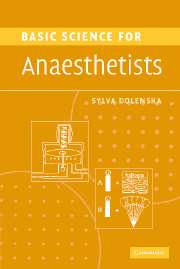Book contents
- Frontmatter
- Contents
- List of abbreviations and symbols
- List of figure captions
- Forewords
- Preface
- Preface to the second edition
- Part 1 Physics, mathematics, statistics, anaesthetic apparatus
- Part 2 Clinical measurement
- 1 Basic measurement concepts
- 2 Electromanometers, frequency response and damping
- 3 Pulse oximeter principle
- 4 Oxygen content and oxygen tension measurement
- 5 Capnography
- 6 [H+], pH and its measurement
- 7 Principles of measurement of volume and flow in gases and liquids
- 8 Cardiac output measurement by thermal dilution technique
- 9 Measurement of the mechanical properties of the chest
- 10 Lung volumes and their measurement
- Part 3a Physiology: the cardiovascular system
- Part 3b Physiology: the respiratory system
- Part 4 Pharmacology
- Further Reading
- Index
9 - Measurement of the mechanical properties of the chest
from Part 2 - Clinical measurement
Published online by Cambridge University Press: 13 August 2009
- Frontmatter
- Contents
- List of abbreviations and symbols
- List of figure captions
- Forewords
- Preface
- Preface to the second edition
- Part 1 Physics, mathematics, statistics, anaesthetic apparatus
- Part 2 Clinical measurement
- 1 Basic measurement concepts
- 2 Electromanometers, frequency response and damping
- 3 Pulse oximeter principle
- 4 Oxygen content and oxygen tension measurement
- 5 Capnography
- 6 [H+], pH and its measurement
- 7 Principles of measurement of volume and flow in gases and liquids
- 8 Cardiac output measurement by thermal dilution technique
- 9 Measurement of the mechanical properties of the chest
- 10 Lung volumes and their measurement
- Part 3a Physiology: the cardiovascular system
- Part 3b Physiology: the respiratory system
- Part 4 Pharmacology
- Further Reading
- Index
Summary
Static compliance (C = ΔV/Δp)
The change in volume is measured as the patient takes a breath from a spirometer
A change in pressure is given as the difference between pleural and alveolar pressure. Direct pleural pressure measurement would produce a pneumothorax; oesophageal pressure is a good approximation. With the glottis open and after equilibration, the mouth pressure is (for measurement purposes) equal to alveolar pressure. The measurement is taken at different lung volumes, and compliance is calculated from the slope of the pressure/volume plot. See the chapter on respiratory mechanics for the plot.
Airways resistance (R = Δp/Q = palv − pmouthQ)
The pressure gradient is the difference between alveolar and mouth pressures during flow.
Mouth pressure can be measured directly by a pressure transducer; alveolar pressure has to be derived, for instance, as a reciprocal value to a change in pressure inside an airtight box (body plethysmograph) during tidal breathing. In Figure 82, the pressure waveform of alveolar pressure and pressure inside the box are plotted against each other to show the relationship.
Flow is measured directly by a pneumotachograph, and resistance calculated.
- Type
- Chapter
- Information
- Basic Science for Anaesthetists , pp. 102 - 103Publisher: Cambridge University PressPrint publication year: 2006



